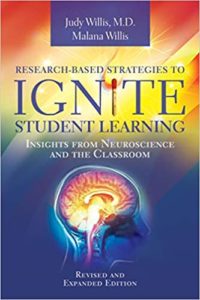Strategies to Ignite Student Learning
Research-Based Strategies to IGNITE Student Learning: Insights from Neuroscience and the Classroom, Revised and Expanded Edition
By Judy Willis, MD and Malana Willis
(ASCD, 2020 – Learn more)

This is 200+ pages of pure gold. Dr. Judy Willis and her daughter Malana have brought us an exceptional volume.
As the title suggests, this is a well-researched and referenced book that uses research, as well as personal experience (they are both veteran K-12 teachers), to give us a plethora of strategies to use with our students to kick their learning to the next level (no matter what their current level is).
Much as great physicians base their treatment strategies on their understanding of the workings of the human body, so too must teachers base their strategies on neuroscience. After all, education and learning rely on the brain and forever alter it.
Neuroscience in laypersons’ terms

The four chapters of the book are well laid out in a progressive order that helps the reader to understand more and more of the workings of the brain as they progress through the book. And readers will find valuable strategies and resources at every step.
Chapter 1: How Red Wagons Capture Students’ Attention describes how and why the brain attends to some things and ignores others, including our instruction at times, and how to make our instruction immune to distraction.
Chapter 2: How Emotions and Stress Affect Learning delves deeper into the workings of the brain to help us understand the possible catalysts and extinguishers as the brain decides whether and how to process incoming information. We also learn how to overcome the natural fight, flight, or freeze responses to our teaching.
Chapter 3: The Journey from Sensory Intake to Memory addresses the inner workings of the brain and how information is stored, pruned and connected, providing insight and strategies on how to best access our brains for long-term memory and retrieval (learning) – including the power of gaming techniques.
Chapter 4: Building Powerful Executive Functions: Skills for the School Years and Beyond, the final chapter, addresses how to teach students at every age and stage to build the key executive functions of goal setting and achieving, organization, prioritizing, judgment and reasoning, critical analysis and cognitive flexibility.
Helping students understand how their brains work to learn
While the authors’ strategies may require a shift in mindset for both us and our students, they make it easy for us to incorporate and teach these strategies in any content at any grade level starting tomorrow.
This book is a great resource to help teachers better understand the current research in neuroscience, to be better equipped as “brain architects” and engineers and to easily implement strategies that will significantly impact our students’ learning today and better prepare them for an ever changing future.
This should be required reading for every pre-service teacher and veteran teacher alike.
Dr. Laura Von Staden is currently a Middle School Gifted Math and Science teacher in Tampa, Florida. She serves on numerous committees in her school district, works closely with the local university, and writes curriculum. She is also a professional development consultant, and previously served as an Exceptional Student Education Specialist, and as a mentor.


































